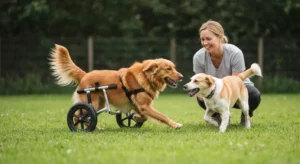A perfect storm of economic stability, evolving workplace culture, and a heightened focus on mental well-being is driving pet adoption rates to historic highs across the United States in 2025. Animal shelters, once grappling with overcrowding, are now reporting unprecedented demand, with waiting lists for adoptable dogs and cats becoming increasingly common. This surge, celebrated by animal welfare advocates, is reshaping the pet industry and posing new, complex challenges for shelters, veterinarians, and new owners alike, forcing a nationwide conversation about the infrastructure required to support this new generation of companion animals.
The Unprecedented Surge: A Look at the Numbers
The data paints a clear picture of a profound shift in American households. According to a landmark Q3 2025 report from the National Animal Shelter Alliance (NASA), a non-profit organization that tracks data from over 4,000 shelters, pet adoption rates have increased by 22% year-over-year. This marks the most significant single-year jump recorded in over two decades.
The report, titled “The Changing American Petscape,” reveals several key demographic trends. Millennials and Gen Z now represent the largest cohort of new pet owners, accounting for 65% of all adoptions in the past year. This is a dramatic increase from just 35% a decade ago, indicating a fundamental generational shift in attitudes toward pet ownership.
“We are witnessing a structural change, not just a temporary spike,” stated Sarah Jenkins, Executive Director of NASA, in a press release accompanying the report. “The desire for animal companionship has become a central feature of modern life, especially for younger adults navigating their careers and personal lives.”
The trend is not uniform across all animal types. While dog adoptions are up by a robust 18%, cat adoptions have seen an even more dramatic increase of 27%. Analysts suggest this may be due to cats being perceived as better suited for smaller living spaces, such as apartments, which are increasingly common among the primary adopting demographics.
Driving Forces: The ‘Why’ Behind the Adoption Boom
Experts point to a convergence of three major societal factors that are fueling the record-breaking pet adoption rates.
The New Work-Life Equation
The widespread adoption of permanent remote and hybrid work models has arguably been the single most significant catalyst. The flexibility to be home during the day has removed a long-standing barrier for many would-be pet owners who previously worried about leaving an animal alone for eight to ten hours.
“The ‘Future of Work’ is officially pet-friendly,” says Liam O’Connell, a lead researcher at Global Workplace Analytics, a firm that studies workforce trends. “Our 2025 data shows that nearly 70% of American companies now offer permanent hybrid or fully remote work policies. This isn’t a temporary accommodation anymore; it’s a core part of employee retention strategies. For millions, this policy shift was the final green light they needed to adopt a pet.”
This stability in remote work culture has given individuals the confidence to commit to the long-term responsibility of a pet, knowing their daily routine can support it. The midday dog walk or the ability to socialize a new puppy is no longer a logistical nightmare but an integrated part of the remote workday.
Economic Confidence and Shifting Priorities
Following years of volatility, a more stable economic outlook in 2025 has provided the financial security necessary for households to take on the cost of a pet. With inflation rates stabilizing and a strong job market, the estimated $1,500 to $2,000 annual cost of caring for a dog or cat feels more manageable for a broader segment of the population.
Dr. David Chen, a sociologist at Stanford University specializing in human-animal studies, argues that this financial confidence is intersecting with changing social norms. “For many Millennials and Gen Z, adopting a pet has become a significant life milestone, akin to buying a car or even a first home in previous generations,” Dr. Chen explains. “It’s a way to build a family and create a home on their own terms. In an era where traditional milestones are often delayed, pet adoption offers an accessible and emotionally fulfilling way to establish a sense of responsibility, nurturing, and domesticity.”
The Mental Health Imperative
The role of companion animals in supporting mental and emotional health is no longer an anecdotal observation but a widely accepted scientific fact, and this awareness is driving adoption decisions. In an age of digital saturation and persistent social anxieties, pets offer a tangible source of comfort and unconditional affection.
“The medical community is increasingly ‘prescribing’ companionship as a powerful tool against loneliness and anxiety,” notes Dr. Lena Petrova, Chief Veterinary Officer for the American Society for the Prevention of Cruelty to Animals (ASPCA). “The physiological benefits are well-documented: interacting with an animal can lower cortisol levels, reduce blood pressure, and release oxytocin. People are actively seeking these benefits, and animal shelters are the primary beneficiaries of this search for well-being.”
A recent study from the Journal of Human-Animal Interaction corroborates this trend, finding that 74% of new adopters in 2025 cited “improving my mental health” as a primary reason for getting a pet, up from 55% in 2020.
How Shelters Are Adapting to the Demand
This surge in pet adoption rates has transformed the day-to-day reality for animal shelters. The chronic issue of overcrowding has, in many urban and suburban areas, been replaced by a new challenge: managing high demand and ensuring quality placements.
“It’s a wonderful problem to have, but it is a problem nonetheless,” says Sarah Jenkins of NASA. “Our member shelters have shifted their focus from ‘marketing’ animals to managing a pipeline of prospective adopters. The bottleneck is no longer a lack of homes, but a lack of available animals and the resources to process applications thoroughly.”
In response, shelters are innovating. Many have implemented sophisticated, technology-driven matchmaking systems that use questionnaires and behavioral data to pair animals with the most suitable homes. Post-adoption support has also become a critical area of investment, with shelters offering free training resources, behavioral hotlines, and check-in programs to reduce the risk of returns and ensure the long-term success of each placement.
The Ripple Effect: Challenges and Considerations
The boom in pet ownership is creating waves across society, bringing both opportunities and significant challenges that extend far beyond the shelter walls.
The Veterinary Care Crunch
The animal healthcare system is straining under the weight of millions of new patients. A nationwide shortage of veterinarians and veterinary technicians, a problem that predated the adoption boom, has now reached a critical point. New pet owners are discovering that booking a routine vet appointment can take weeks, and emergency services are facing overwhelming caseloads.
“The infrastructure for animal healthcare is struggling to keep pace with the explosion in the pet population,” warns Dr. Petrova of the ASPCA. “We are seeing increased burnout in the veterinary profession and very real concerns about access to care, especially in rural areas and for low-income pet owners. This is a public policy challenge that needs immediate attention.”
Ensuring ‘Forever’ Homes
While current pet adoption rates are high, animal welfare organizations remain vigilant about the potential for an increase in returns if circumstances change. The primary concern is what might happen if the economy falters or if a significant number of companies reverse their remote work policies.
“Our adoption counseling has become more rigorous than ever,” Jenkins emphasizes. “We spend a lot of time discussing the ‘what ifs’ with potential adopters. What is your plan if you have to return to the office? What is your financial safety net for a major veterinary expense? Our goal has evolved from just getting animals adopted to ensuring these adoptions are successful for life.”
The Rise of Pet-Friendly Infrastructure
This new reality is reshaping physical communities. Real estate developers are increasingly designing apartment buildings with pet-centric amenities like rooftop dog runs and on-site pet washing stations. A report from the National Association of Realtors found that in 2025, listings mentioning “pet-friendly” features sold 15% faster and for a 5% higher price on average. Cities are also responding by investing more in dog parks and reviewing regulations to allow pets in more public spaces, from restaurant patios to public transit.
Looking Ahead: Is This the New Normal?
As 2025 draws to a close, the question on everyone’s mind is whether these high pet adoption rates represent a sustainable new normal. Most experts believe that while the initial explosive growth may level off, a permanently elevated rate of pet ownership is here to stay.
“This isn’t a fad; it’s a fundamental re-evaluation of the role of animals in our lives,” concludes Dr. Chen. “The integration of pets into our daily routines, workplaces, and mental health strategies is a cultural shift that will not be easily reversed.”
The journey forward will require a concerted effort from all sectors—from policymakers and veterinarians to urban planners and employers—to build a society that can truly support the millions of new bonds being forged between humans and their adopted companions. While the challenges are significant, the overwhelming sentiment is one of optimism: more animals in loving homes is a clear victory for animal welfare, and a testament to the enduring power of the human-animal bond.












